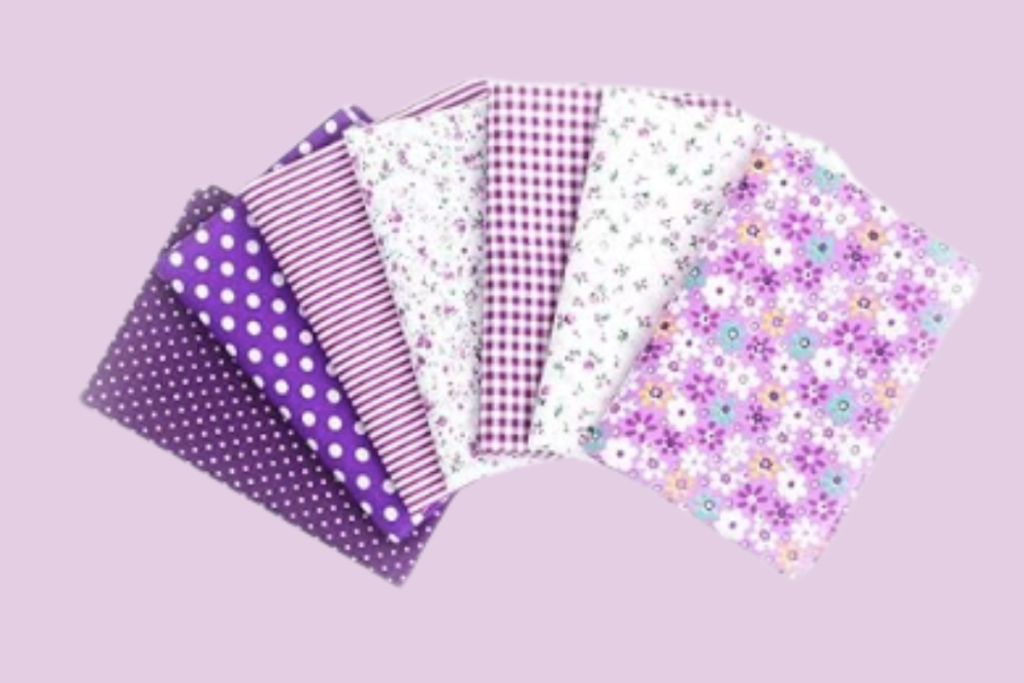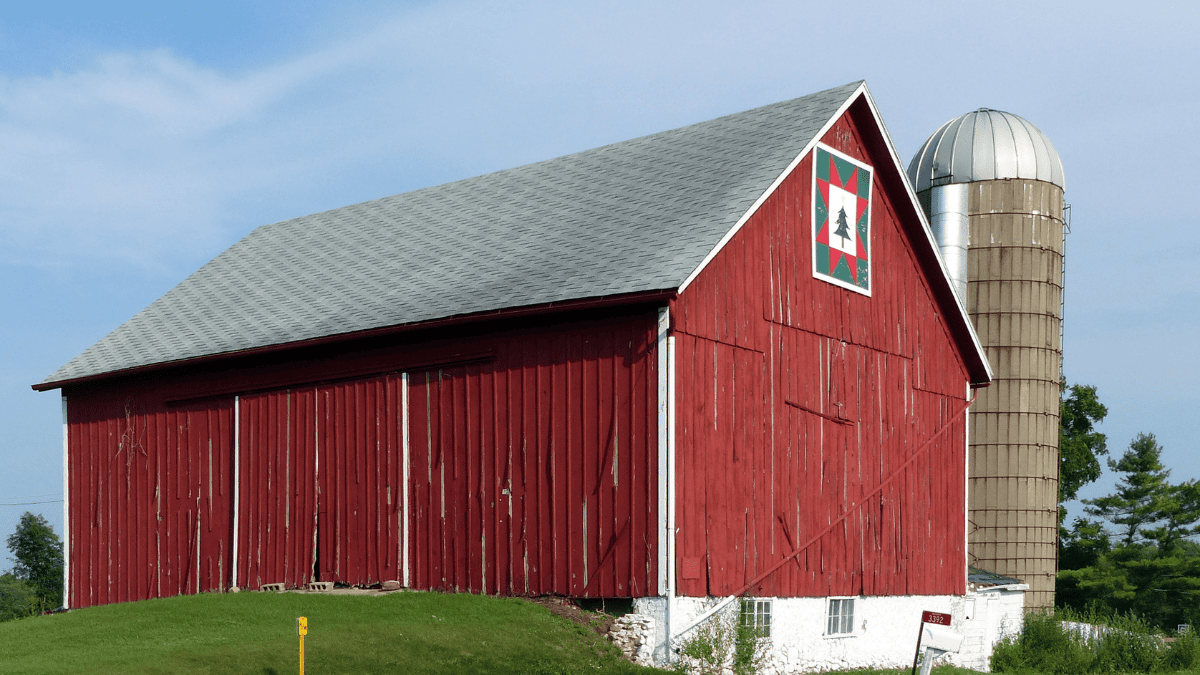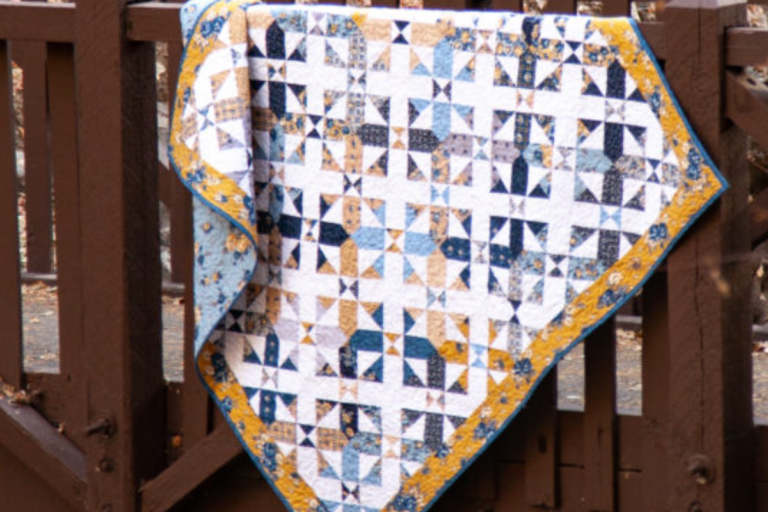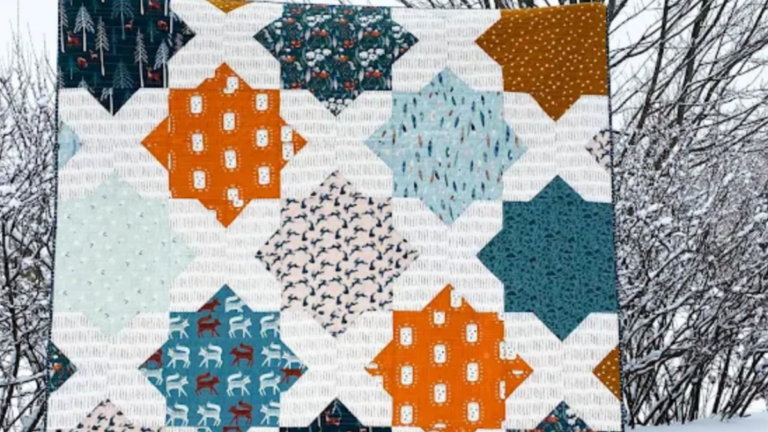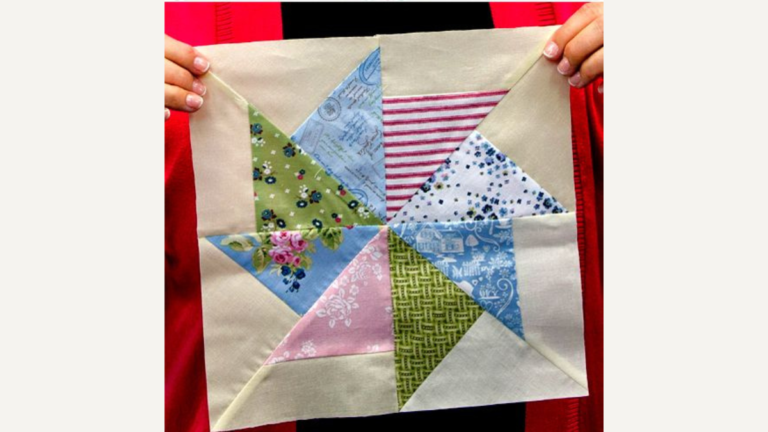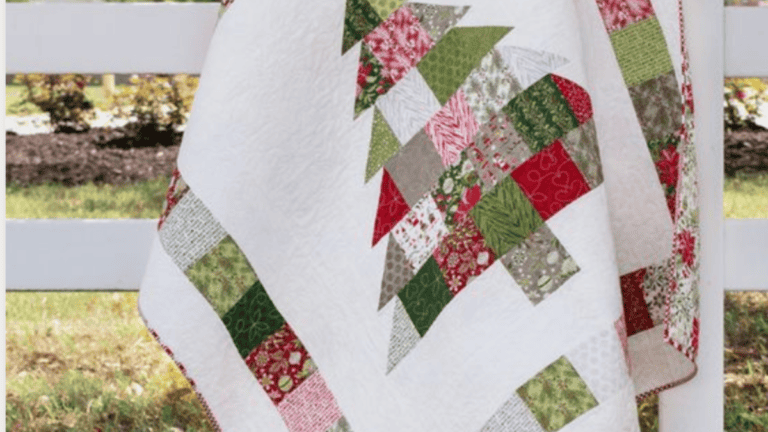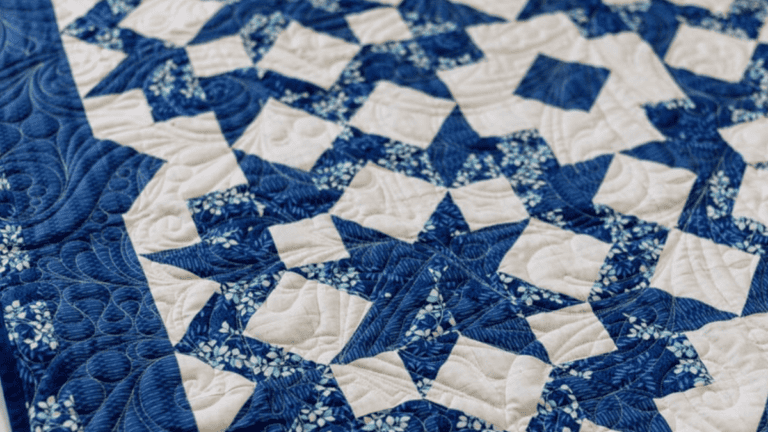What Are Barn Quilts? An Easy Guide On What And How To Make One
What are Barn quilts? They are a colorful piece of rural America that has grown in popularity over the years.
Essentially, they’re large, hand-painted wooden squares that resemble traditional quilt patterns and are hung on the exterior of barns, sheds, or even houses.
You might see them as you drive through the countryside, splashing a dash of color onto the landscape. They’re not only decorative but are also steeped in the history and heritage of the areas where they’re found.
The tradition of barn quilts started in Ohio, but it quickly spread to other states, creating a vibrant tapestry across the United States.
Each barn quilt tells a story, with designs often reflecting the identity of the farm, commemorating local history, or honoring a loved one.
They’re usually mounted on the side of the barn that faces the road, giving passersby a glimpse into the unique characteristics of the region.
You don’t have to be a quilter or a farmer to appreciate these works of art. Barn quilts create a sense of community and celebrate rural craftsmanship.
They can even be part of a “barn quilt trail,” leading enthusiasts on a picturesque journey through the countryside to view a collection of these unique creations.
So next time you’re out for a drive in the country, keep your eyes peeled for these distinctive emblems, each one with its own pattern and story to tell.
What Are Barn Quilts?
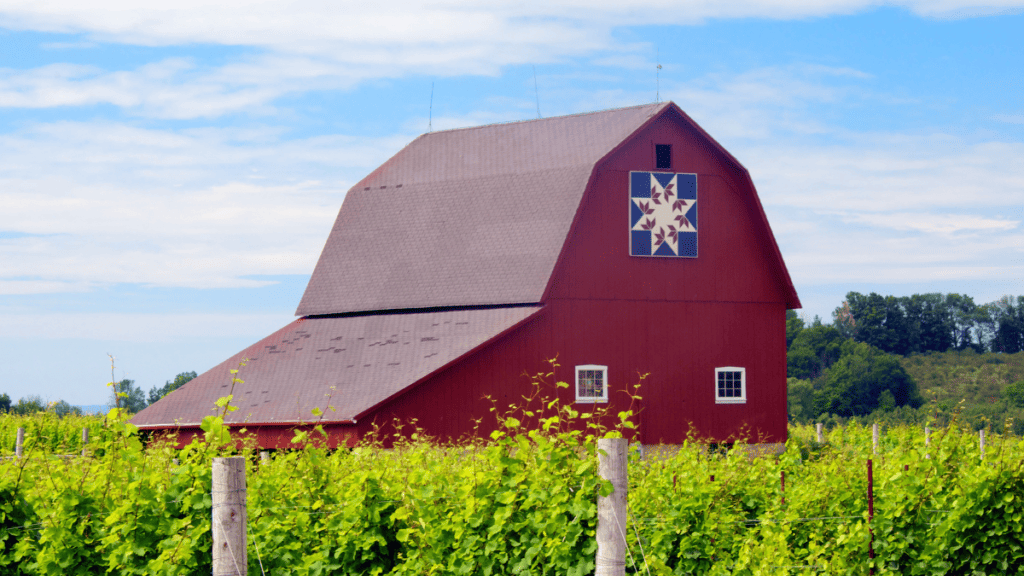
The history of barn quilts is a colorful journey that starts with a personal tribute and blossoms into a widespread community art movement.
Your trek through this story begins with a single creative idea and grows to span across North America, weaving together rural beauty and quilting heritage.
Origins and Donna Sue Groves
Back in 2001, Donna Sue Groves wanted to honor her mother’s Appalachian heritage and love for quilts. So, you find her in Adams County, Ohio, turning a simple barn into a canvas for a quilt block.
This heartfelt gesture sparked what you now recognize as the barn quilt movement, transforming rural landscapes one barn at a time.
Early 2000s and Barn Quilt Movement
By the early 2000s, you see the barn quilt concept picking up the pace. Groves’s vision blossomed, and soon communities started coming together to create their own barn quilt trails.
The effort not only celebrated the art of quilting but also aimed to promote rural heritage, drawing attention to the often-overlooked splendors found in the countryside.
American Quilt Trail Movement
The American Quilt Trail Movement, which gained momentum in the mid-2000s, marks a significant spread of the idea.
You can follow the first official trail in Ohio, but like seeds on the wind, trails quickly spread to neighboring states.
These trails are beacons that guide you through rural America’s scenic byways, with quilts serving as emblems of local identity and history.
Barn Quilts Today
In recent years, the barn quilt trend has continued to flourish. What began as a personal tribute has now become a cultural icon synonymous with rural pride and communal effort.
You’ll find barn quilts adding splashes of color and pattern to barns across the United States and Canada, each telling a story, celebrating a history, or marking a tradition unique to its locale.
Barn Quilt Designs
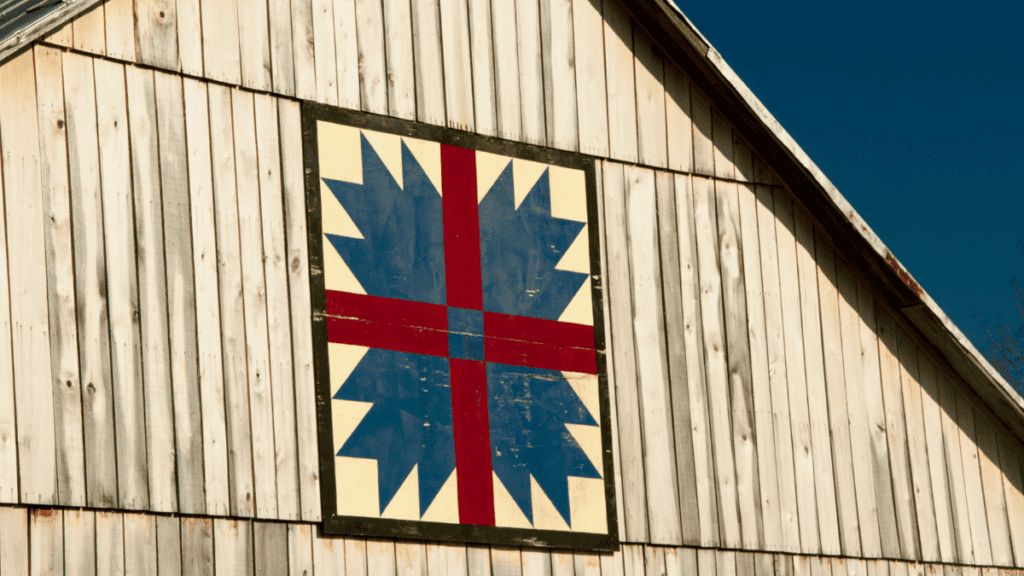
Barn quilts boast diverse designs, each carrying its own story and flair. Whether it’s the complexity of the pattern or the vibrancy of the colors, these works of art reflect deep-seated traditions and personal expressions.
Quilt Block Patterns
Quilt squares are the foundation of barn quilts, with each square composed of a distinctive quilt pattern.
In your travels, you might spot traditional quilt patterns rooted in history, like the Ohio Star or Compass Star, which often consist of simple geometric shapes.
These patterns serve not just as decoration, but also to connect with a region’s quilting heritage.
Symbolic Meanings and Folk Art
Each quilt block pattern holds more than just aesthetic value; they can symbolize personal stories or local lore. For instance, hex signs or patterns like Snail’s Trail often embed tales or hopes within their designs.
This integration of folk art into barn quilts creates a rich tapestry of communal and individual identities.
Color Choices and Patterns
When you look at barn quilts, the interplay of solid colors and bold colors cannot be overlooked.
While solid colors offer a nod to classic design, bold colors breathe life into patterns, making designs like the Ohio Star pop from a distance.
It’s not just about looking pretty; the color choices in barn quilts can reflect factors such as a family’s tradition or the purpose of the quilt pattern itself.
Cultural and Community Impact

Barn quilts aren’t just about adding a splash of color to old barns; they’re a movement that’s revitalizing rural communities and celebrating local heritage across North America.
Rural Revitalization and Tourism
Your drive through the countryside might get a lot more scenic thanks to barn quilts. This grassroots public art movement has turned rural areas into open-air galleries, sparking economic growth through tourism.
Take Adams County, Ohio, for example, where their barn quilt trail—a series of barns featuring painted quilt squares—has become a significant tourist attraction.
Counties like Sac County in Iowa have followed suit, drawing road trippers and transforming the local economy by enticing visitors to explore less traveled rural roads.
- Economic Impact:
- Increased tourist visits
- Support for local businesses
Barn Quilts and Local Heritage
Barn quilts are more than just decorative; they honor family traditions and regional stories.
In the Midwestern states, and places like southwestern Ontario, local barns are often adorned with quilt patterns that mean something special to the community.
Take the Village of Wardsville, for example, where barn quilts serve as a nod to the town’s founder and their legacy. It’s a powerful way to connect with your ancestry, rooted deep in rural life.
- Heritage Preservation:
- Quilt patterns representing family stories
- Promotion of regional heritage
Community Projects and Quilt Trails
Imagine being part of something that stitches your community closer together. Quilt guilds and various local groups across small towns have taken up the task of creating quilt trails, like the Chatt Hills Barn Quilt Trail
in Georgia or the trails meandering through the scenic views of West Virginia, encouraging community involvement.
These projects foster a sense of unity and pride, allowing communities in places like North Carolina’s Amish Country to share their heritage with visitors and neighbors alike.
- Community Benefits:
- Strengthened community bonds
- Increased civic pride
Remember, it’s not just about the quilts; it’s the spirit they embody and the communities they enhance—yours could be next!
Craftsmanship and Creation

When you embark on creating a barn quilt, you’re combining artistic flair with hands-on skills. This process demands precision, creativity, and an understanding of materials that will ensure your masterpiece withstands the test of time.
Materials and Tools
To get started, you’ll need a large piece of wood – typically a smooth plywood that’s at least 1/2 inch thick for sturdiness. As you head to Home Depot or your local hardware store, make a checklist:
- Plywood (sanded and cut to your desired size)
- Back braces (to support and secure the quilt)
- Screws (stainless steel is ideal for outdoor use)
- Drill (for assembling your quilt)
- Sandpaper (fine grit for smooth finishing)
- Painter’s tape (to achieve clean lines)
Paint Selection and Techniques
Choosing the type of paint is crucial, especially considering your barn quilt might adorn your front porch and face outdoor elements. Opt for outdoor use latex paint for its resilience and color retention.
Here’s a simple strategy for selecting paint:
- Determine your color scheme – this can stem from personal preference or creative ideas inspired by your surroundings.
- Head to a paint store, and be specific about needing paint suitable for outdoor use.
Then, for application:
- Use a primer to seal the wood.
- Apply at least two coats of paint, allowing drying time between coats.
- Finish with a clear sealant for protection against weather.
Installation and Preservation
To ensure your barn quilt remains a vibrant symbol of your creativity, installation and preservation are key. Attach back braces horizontally to reinforce the quilt, preventing warping. When securing your quilt:
- Place screws at each corner and along the braces.
- Ensure it hangs flush against your desired surface, be it a barn, shed, or porch.
Lastly, to preserve your artwork:
- Check yearly for signs of wear.
- Apply a fresh topcoat of sealant to combat moisture and sun damage. Keep it looking fresh for years to come!
Barn Quilts in Public and Private Spaces

Barn quilts add a splash of color and heritage to both rural and urban landscapes, bringing the simple elegance of quilting art to public view and intimate home settings alike.
Barns and Buildings
Old and historic barns often exhibit large, colorful quilt patterns on their exteriors, transforming traditional agricultural structures into vivid landmarks.
In many areas across the United States, such as Ohio, a “clothesline of quilts” can be seen where a collection of barn quilts creates an informal driving tour.
Each painted quilt displays a single quilt block or a simple geometric pattern of squares, boasting designs that represent folklore or family heritage.
- Example: The Historic Landmarks of the rural Midwest often include a beautiful barn quilt on the side of a barn, turning a plain tobacco barn into a piece of public folk art.
- Popularity: Following their inception at an International Plowing Match in 2001, barn quilts gained popularity and support from organizations such as the Ohio Arts Council.
Smaller Versions and Home Decor
For those who wish to display a piece of this classic Americana without owning a barn, smaller versions of barn quilts serve as home decor.
A smaller version of a barn quilt can be hung on the wall like any work of art, often symbolizing good fortune or good luck.
The artistry behind today’s barn quilts echoes through these miniaturized forms, making them accessible in personal spaces.
- Types: Homeowners order custom pieces that include everything from a single quilt block to more complex arrays of colorful squares.
- Inspiration: A kind barn quilt might inspire a new project or be given as a gift to wish someone better ways.
Barn Quilt Patterns
See all Barn Quilt Patterns
We have an entire library of barn quilt patterns so that you can make your own for your home or farm. Here are a few of our favorites
Barn quilt patterns for beginners
Fabric Giveaway
Enter our monthly fabric giveaway. Simply complete the tasks daily and you will be entered into the drawing. Winner will be randomly drawn on the first day of the month and notified via email
